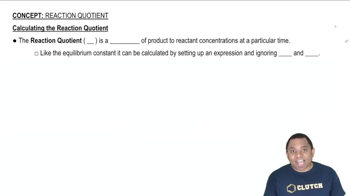Consider the reaction: A(g) ⇌ B(g) + C(g) Find the equilibrium concentrations of A, B, and C for each value of Kc. Assume that the initial concentration of A in each case is 1.0 M and that the reaction mixture initially contains no products. Make any appropriate simplifying assumptions. b. Kc = 0.010
Ch.16 - Chemical Equilibrium
Chapter 16, Problem 68a
Consider this reaction at equilibrium: 2 BrNO(g) ⇌ 2 NO(g) + Br2(g) Predict whether the reaction will shift left, shift right, or remain unchanged after each disturbance. a. NO is added to the reaction mixture.
 Verified step by step guidance
Verified step by step guidance1
Identify the reaction and the change applied: The reaction given is 2 BrNO(g) ⇌ 2 NO(g) + Br2(g), and the disturbance is the addition of NO(g) to the reaction mixture.
Recall Le Chatelier's Principle, which states that if a system at equilibrium is disturbed, it will adjust itself to counteract the disturbance and restore a new equilibrium.
Analyze the effect of adding NO(g): Adding more NO(g) increases the concentration of NO(g) on the right side of the equation.
Predict the shift due to the disturbance: According to Le Chatelier's Principle, increasing the concentration of a product (NO(g)) will shift the equilibrium to the left to reduce the concentration of NO(g) by converting it back to BrNO(g).
Conclude the direction of the shift: The reaction will shift to the left in response to the addition of NO(g).

Verified video answer for a similar problem:
This video solution was recommended by our tutors as helpful for the problem above.
Video duration:
1mWas this helpful?
Key Concepts
Here are the essential concepts you must grasp in order to answer the question correctly.
Le Chatelier's Principle
Le Chatelier's Principle states that if a dynamic equilibrium is disturbed by changing the conditions, the system will adjust to counteract the change and restore a new equilibrium. This principle helps predict the direction of the shift in equilibrium when a reactant or product concentration is altered.
Recommended video:
Guided course

Le Chatelier's Principle
Equilibrium Constant (K)
The equilibrium constant (K) is a numerical value that expresses the ratio of the concentrations of products to reactants at equilibrium for a given reaction at a specific temperature. Changes in concentration, pressure, or temperature can affect the value of K, influencing the position of equilibrium.
Recommended video:
Guided course

Equilibrium Constant K
Reaction Quotient (Q)
The reaction quotient (Q) is a measure of the relative concentrations of products and reactants at any point in time, not just at equilibrium. By comparing Q to K, one can determine the direction in which the reaction will shift to reach equilibrium: if Q < K, the reaction shifts right; if Q > K, it shifts left.
Recommended video:
Guided course

Reaction Quotient Q
Related Practice
Textbook Question
1
views
Textbook Question
Consider this reaction at equilibrium: 2 BrNO(g) ⇌ 2 NO(g) + Br2(g) Predict whether the reaction will shift left, shift right, or remain unchanged after each disturbance. b. BrNO is added to the reaction mixture.
Textbook Question
Consider this reaction at equilibrium: 2 BrNO(g) ⇌ 2 NO(g) + Br2(g) Predict whether the reaction will shift left, shift right, or remain unchanged after each disturbance. c. Br2 is removed from the reaction mixture.
Textbook Question
Consider this reaction at equilibrium:
C(s) + H2O(g) ⇌ CO(g) + H2(g)
Predict whether the reaction will shift left, shift right, or remain unchanged after each disturbance.
a. C is removed from the reaction mixture.
